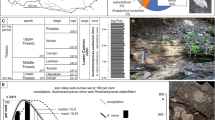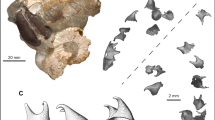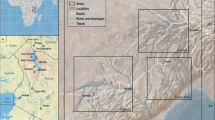Abstract
IT has long been recognized that the Jurassic and Cretaceous ammonoids are very different from those of the Triassic and it is generally concluded that the whole order Ammonoidea nearly became extinct at the Triassic–Jurassic boundary. More than a century ago Suess1 recognized that one group, the phylloceratids, was common to both systems. Most authors2–5 have accepted this view and have further concluded that the phylloceratids provide the only link between the faunas of the Triassic and the Jurassic. In taxonomic terms this is expressed by Arkell et al.5 as follows: Jurassic and Cretaceous ammonoids comprise suborders Phylloceratina, Lytoceratina and Ammonitina. Of these only Phylloceratina extend back into the Triassic. In the Lower Triassic, Phylloceratina merge with Ceratitina, the dominant Triassic group, which became extinct at the end of the Triassic. It was the opinion of Arkell et al. that both Lytoceratina and Ammonitina were derived from Phylloceratina.
This is a preview of subscription content, access via your institution
Access options
Subscribe to this journal
Receive 51 print issues and online access
$199.00 per year
only $3.90 per issue
Buy this article
- Purchase on Springer Link
- Instant access to full article PDF
Prices may be subject to local taxes which are calculated during checkout
Similar content being viewed by others
References
Suess, E., Sitzungber. Akad. Wiss. Math.-Naturwiss. Kl., 52 (I–II), 1, 71 (1865).
Spath, L. F., Cat. Fossil Cephalopoda Brit. Mus. (NH), Part IV (1934).
Arkell, W. J., J. Paleontol., 24, 354 (1950).
Donovan, D. T., Biol. Rev. Cambridge Phil. Soc., 39, 259 (1964).
Arkell, W. J., et al., Treatise on Invertebrate Paleontology, Part L (Geol. Soc. Amer., and Univ. Kansas Press, 1957).
Wiedmann, J., Eclogae Geol. Helv., 63, 923 (1970).
Arthaber, G. v., Jb. Mijnw. Ned. Oost.-Ind., 55, 1 (1927).
Basse, E., in Traité de Paleontologie (edit. by Piveteau, J.), 2, 461 (Masson, Paris, 1952).
Schindewolf, O. H., Akad. Wiss. Lit. Mainz, Abh. Math.- Naturwiss. Kl., 1960, 635 (1961).
Teichert, C., Univ. Kansas Dept. Geol. Spec. Publ. 2, 162 (1967).
Wiedmann, J., Neues Jb. Geol. Paläontol. Abh., 125, 49 (1966).
Shevyrev, A. A., Tr. Paleont. Inst. Akad. Nauk. SSSR, 119 (1968).
Burck, H. D. M., Jb. Mijnw. Ned. Oost.-Ind., 49, 1 (1923).
Diener, C., Jaarb. Mijnw. Ned. Oost.-Ind., 49, 73 (1923).
Hauer, F. v., Denkschr. Akad. Wiss. Wien, 63, 237 (1896).
Popov, Yu. N., Tr. Nauch.-Issled. Inst. Geol. Arktiki, 79 (1961).
Kullmann, J., and Wiedmann, J., Univ. Kansas Paleontol. Contr., 47 (1970).
Frebold, H., Geol. Survey Canada Bull., 158 (1967).
Author information
Authors and Affiliations
Rights and permissions
About this article
Cite this article
TOZER, E. One, Two or Three Connecting Links between Triassic and Jurassic Ammonoids?. Nature 232, 565–566 (1971). https://doi.org/10.1038/232565a0
Received:
Issue Date:
DOI: https://doi.org/10.1038/232565a0
This article is cited by
-
Über den Kieferapparat der Lytoceratacea (Ammonoidea)
Paläontologische Zeitschrift (1980)
Comments
By submitting a comment you agree to abide by our Terms and Community Guidelines. If you find something abusive or that does not comply with our terms or guidelines please flag it as inappropriate.



